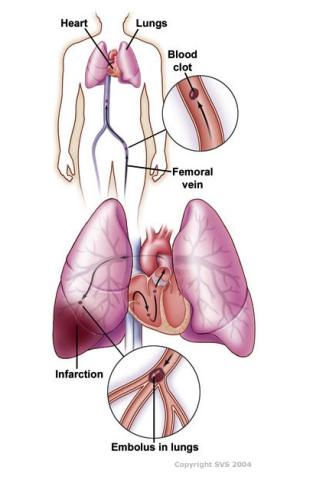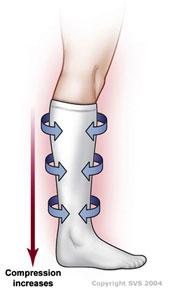A pulmonary embolism (PE) occurs when a blood clot suddenly blocks a major artery in your lung. These clots usually form in another part of your body, such as your leg or arm, before breaking off and traveling through the bloodstream to your lungs. This blockage can prevent your heart from pumping properly and prevents it from taking in oxygen.
Pulmonary embolism is the third most common cardiovascular condition after heart attack and stroke.
Call 911 Immediately
A pulmonary embolism is a life-threatening emergency. If you notice any of the symptoms listed below, call 911 or seek medical help immediately.

Signs of a Pulmonary Embolism
Symptoms usually begin suddenly and may include:
- Sudden shortness of breath.
- Sharp chest pain, often aggravated by coughing or movement.
- Pain in your back.
- A persistent cough, with or without blood.
- Excessive sweating.
- Rapid pulse or breathing.
- Lightheadedness or passing out.
- Blue lips or nail beds.
If you notice these symptoms, seek medical attention immediately.
Signs of a Blood Clot in a Leg or Arm
In most cases, a pulmonary embolism starts as a blood clot in the leg or arm. If the clot breaks free and travels to the lungs, it can block blood flow and cause a pulmonary embolism. Watch for these signs of a blood clot in your leg or arm:
- Swelling of the affected leg or arm.
- Leg pain or tenderness that may only occur when you are standing or walking.
- Increased warmth in the swollen or painful area of the affected leg or arm.
- Redness or discoloration of your skin.
- Enlargement of superficial veins in the affected leg or arm.
The most common cause of pulmonary embolism is a condition called deep vein thrombosis (DVT).
A variety of risk factors contribute to the development of pulmonary embolism:
- Surgery, particularly abdominal or orthopedic surgery, such as hip or knee surgery.
- Trauma or bone fracture.
- A long period of bed rest or sitting for a long time, perhaps on an airplane or in a car.
- Cancer and some cancer treatments, like chemotherapy.
- Cardiovascular diseases such as atrial fibrillation, heart failure, heart attack or stroke.
- Pregnancy and the first 6 weeks after giving birth.
- Birth control pills or hormones taken for symptoms of menopause.
- Family history of blood clots.
- Inherited blood disorders that make the blood thick, such as thrombophilia.
- Inflammatory bowel disease.
- Auto-immune diseases, such as lupus or antiphospholipid syndrome.
- Smoking.
- Obesity.
- Placement of vein catheters, pacemakers or implantable defibrillators.
You will be asked questions about symptoms and medical history, including questions about family members.
Your doctor will also perform a physical exam, and they may recommend tests to confirm and assess the pulmonary embolism including:
- Chest x-ray
- Computerized Tomography Angiogram (CTA)
- Echocardiogram (Echo)
- Ventilation Perfusing Lung Scanning (VQ Scan)
- Ultrasound of your leg veins (Duplex)
- Pulmonary Angiography
- Blood tests: D-dimer, Troponin, BNP (brain natriuretic peptide - hormone) and arterial blood gas analysis
A pulmonary embolism is a medical emergency and treatment is essential. Treatment may include:
- Percutaneous Mechanical Thrombectomy: This is a minimally invasive procedure to remove the clot directly from the lung and is increasingly the first choice in many cases.
- Clot-Busters: Clot busters are taken intravenously, through an IV in the arm (systemic thrombolysis) or through a long catheter (thin tube) that delivers them directly to a clot in the lung (catheter-directed thrombolysis).
- Anticoagulation Therapy: Blood thinners may still be used in less severe cases to prevent further clots.
- Surgery: Open surgery to physically remove the clot is rarely performed and a last resort when other treatments are not viable. This is typically performed by cardiac surgeons.
Long-Term Effects
After beginning treatment, blood clots in your lung will need months or years to completely resolve. You may develop pulmonary hypertension (or high blood pressure in the arteries that carry blood from the heart to the lungs) with life-long implications, including shortness of breath and exercise limitations.
If you have had pulmonary embolism once, you are more likely to have it again. Your vascular surgeon will recommend ways to prevent pulmonary embolisms in the future:
- Stay active and exercise regularly.
- Wear elastic compression stockings, particularly if you need to sit or stand for long periods.
- Walk or flex and stretch your legs every hour on long plane or car trips. (Check out these exercises you can do while flying.)
- If you can't walk - due to bed rest, recovery from surgery or extended travel - move your arms, legs and feet for a few minutes each hour.
- Use anticoagulants (blood thinners) as prescribed. If you become aware of times when you will have limited mobility, like during surgery or prolonged bed rest, discuss with your doctor whether a temporary change in dosage is recommended.
- Drink plenty of fluids, like water and juice, and avoid excess alcohol and caffeine.
- Do not smoke. (Find resources on how to quit smoking.)
- Maintain an optimal weight.

